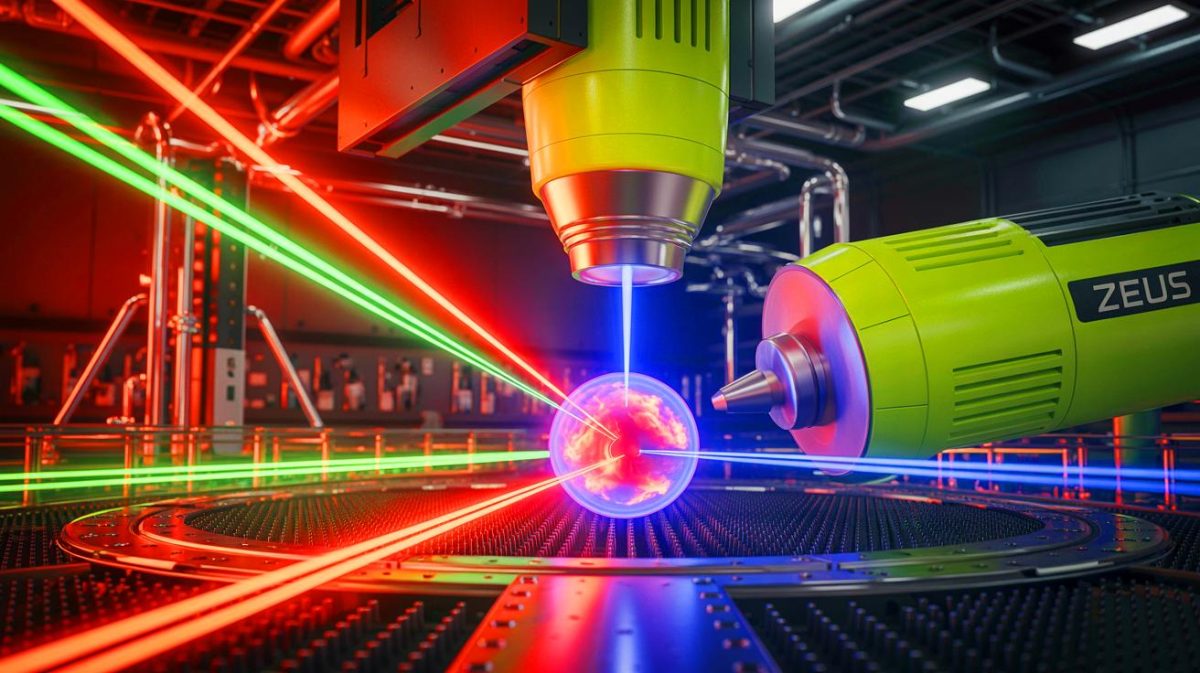| IN A NUTSHELL |
|
The United States has made a groundbreaking leap in laser technology with the activation of ZEUS (Zettawatt-Equivalent Ultrashort Pulse Laser System), a device of exceptional power. Recently, physicists conducted their first experiment with this laser, which is not only the most powerful in the U.S. but also one of the most potent in the world. This impressive tool paves the way for significant advancements in physics, medicine, and materials science. With its unparalleled capabilities, ZEUS stands to revolutionize multiple scientific fields.
The ZEUS System
ZEUS can generate a staggering power of 2 petawatts (equivalent to 2 quadrillion watts) for an incredibly short duration of 25 quintillionths of a second. To put it in perspective, this represents more than 100 times the world’s electrical power concentrated in an instant. Remarkably, this laser is twice as powerful as any other available in the United States.
Anatoly Maksimchuk, an engineer at the University of Michigan and head of experimental zone development, explains that the goal is to achieve even higher electron energies. To accomplish this, two distinct laser beams will be used: one to create a guiding channel and the other to accelerate electrons through this channel. The acceleration process is based on the interaction between the laser pulse and a target cell containing helium. As the laser passes through this gas, it generates a plasma, a kind of “soup” composed of charged particles. Electrons in this plasma are then propelled to incredible speeds, much like surfers riding the waves of a speedboat.
A Planned Power Increase
Behind ZEUS’s performance is cutting-edge engineering. The system’s core relies on a titanium-doped sapphire crystal, measuring 7 inches in diameter. This rare and complex component took over four years to fabricate. Franko Bayer, the director of the ZEUS project, emphasizes that “this crystal is a unique piece in the world.”
The next phase of experimentation plans to increase the power to 3 petawatts. In this configuration, accelerated electrons will collide with a laser pulse coming from the opposite direction. The effect of this encounter will be akin to a head-on collision on a highway, where the perceived power of the pulse will soar to levels up to a million times higher. This planned increase in power underscores the relentless pursuit of scientific advancement.
Toward Concrete Applications
This technological feat marks a pivotal moment in scientific research. According to Slava Lukin, director of the plasma physics program at the National Science Foundation (NSF), ZEUS will allow for the recreation of luminous phenomena and particle accelerations occurring in the universe’s most extreme corners. This type of research could revolutionize our understanding of the cosmos.
While ZEUS’s fundamental interest lies in understanding the laws of physics at the subatomic level, its practical outcomes are equally promising. As Dr. Vyacheslav Lukin, the supervisor of the ZEUS project at the NSF, indicates, this fundamental research installation could lead to various applications. These include enhanced imaging techniques for soft tissues, as well as advancements in cancer treatment and other medical fields. “Researchers using ZEUS will push the boundaries of human knowledge in unprecedented ways,” he asserts enthusiastically.
Revolutionizing Multiple Fields
As ZEUS continues to push the limits of laser technology, its potential applications extend far beyond the laboratory. In addition to its scientific implications, the laser’s immense power could redefine military capabilities, offering new avenues for defense and strategic applications. The ability to simulate extreme cosmic conditions on Earth opens up a realm of possibilities for testing materials and devices under conditions previously unreachable.
Moreover, the collaboration between scientists and engineers in this project highlights the importance of interdisciplinary efforts in achieving technological breakthroughs. The success of ZEUS serves as a testament to what can be accomplished when experts from various fields unite toward a common goal. As we stand on the brink of a new era in laser technology, the implications of ZEUS’s capabilities continue to unfold, promising a future rich with discovery and innovation.
ZEUS represents a monumental stride in laser technology, with far-reaching implications for both scientific research and practical applications. As scientists continue to explore its capabilities, the question remains: What new frontiers will ZEUS unlock in the realm of advanced technology and beyond?
Did you like it? 4.3/5 (25)








Wow, 2 petawatts! How does ZEUS even handle that kind of power without exploding? 🤯